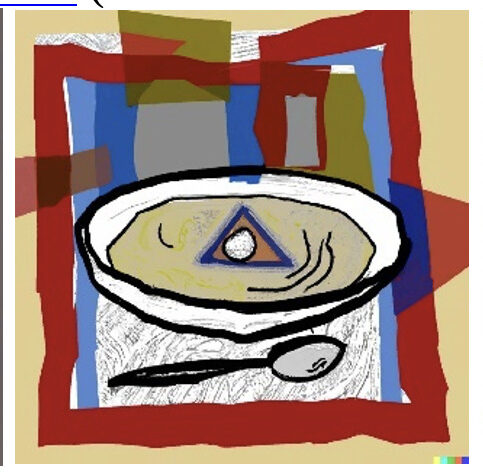“While many people enjoy AI art, it will run out of inspiration if human artists are no longer incentivized to create because their revenue streams have been usurped by machines.”
Scroll through social media and you’re certain to find countless posts of images generated by artificial intelligence, or “AI.” Tools such as DALL-E 2, Starry AI, Jasper, and the like have exploded in popularity, allowing users to do everything from creating stylized versions of the user’s own photographs, to inputting silly, incongruous prompts like “red headed cow with John Lennon sunglasses,” and receiving almost instantaneous results with no further effort by the user. Users have taken to such websites in droves because they are easy to use, free, and most importantly, fun. The problem: in most if not all cases, the AI obtains its images by “scraping” the internet, obtaining and using massive amounts of copyrighted images to train itself in the meaning of certain words and in the stylistic choices employed in those images.
Artists are understandably upset. Andersen et al. v. Stability AI Ltd. et al., a potential class action recently filed in the Northern District of California, alleges that AI art platforms are able to create images that so convincingly mimic a particular artist’s style based on preexisting images of that artist’s work that the AI platforms are “siphoning commissions from the artists themselves.” The complaint refers to the same technology as “merely a complex collage tool.”
Confronting the Paradox
AI art raises several paradoxical themes in copyright law. First, what constitutes a “work” and what constitutes an “author?” Traditionally, a “work” is defined by meeting a minimum level of originality and having been created by a human being. Feist Publications Inc. v. Rural Telephone Services Co., 499 US 340 (1991); Burrow-Giles Lithographic Co. v. Sarony, 111 U.S. 53, 56 (1884); Trade-Mark Cases, 100 U.S 82, 94 (1879). Last February, the U.S. Copyright Office Review Board affirmed denial of a 2018 application to register a purported work generated using AI art because it “lacked the required human authorship necessary to support a copyright claim.”
However, there is a separate doctrine in copyright law allowing a human being to be treated as a “mere amanuensis”—a tool by which the “author” achieves their artistic vision. The S.D.N.Y. has held that a filmmaker was the “author” of footage that was taken by others at his direction, because he “exercised [] a high degree of control over … detail-intensive artistic elements…such that the final product duplicates his conceptions and visions of what the [work] should look like[.]” Lindsay v. Wrecked & Abandoned Vessel R.M.S. TITANIC, No. 97 CIV. 9248 (HB), 1999 WL 816163, at *5 (S.D.N.Y. Oct. 13, 1999). This means that those taking the images at his direction were not considered authors of the footage they filmed.
This raises the paradox: a human being—one who possesses genuine intelligence—is viewed as a tool because they are smart enough to take direction effectively, whereas AI—a literal machine—is not treated as a tool used by a human author because it is not yet sophisticated enough to take complex direction. Put another way, humans are smart enough to be treated like a hammer.
As the Tech Improves, the Legal Hurdles Get Higher
Notably, this comparison only holds so long as AI art generators require trial and error for modifications. Once AI technology improves to the level where users can use sliders or similar value inputs to change specific elements of the resultant image, from the most basic options like the contrast, gama correction and brightness settings found on a computer display or television, to more creative and esoteric options like “scariness,” “romanticism” or “intensity,” this analysis will become moot and it will be much more difficult to argue that there is not sufficient human authorship. At that point, AI art will be functioning like Protools, Photoshop or Final Cut: a tool by which creative choices are made by a human being concerning the final presentation of a work.
The difference between use of the above-mentioned programs and “AI 2.0” is ownership of the inputs. Infringing uses of those programs are much more clear-cut: if someone uses an unlicensed sample in Protools, tracing the authorship of that sample is comparatively easy as in nearly all cases any discrete sample was taken from a single source. If someone retouches a photograph in Photoshop, you can trace the original photograph. But AI art is conceptually different—while it would be possible to require a digital record of all images that the AI had “seen,” the purpose of AI is to synthesize massive amounts of information, not to search for a single image and copy it. In a sense, AI is operating off of an artificial form of inspiration rather than direct copying of a single image.
This muddies the analysis immeasurably. If a human spends a decade going to art school and visiting museums, then creates a pointillist pop-art rendition of Washington Crossing the Delaware, that person is celebrated as having an understanding of the vocabulary—of knowing the rules well enough to break them. However, if an AI views millions of images online and creates “a bowl of soup that is a portal to another dimension in the style of Basquiat,” we view it as potentially copyright infringement. (All images available on the homepage for DALL-E-2 at https://openai.com/dall-e-2/ (last visited 1/29/2023)).

While all things AI are rife with moral and ethical conundrums, under copyright law as it currently stands there is nothing protecting an artist’s unique style, only their specific works. Therefore, the potential for infringement lies with the acquisition of images, such as by download, not with the use of vast numbers of images to generate new works. Were a human being on trial for infringement, “but, your honor, I didn’t copy one image, I was copying parts of thousands of images” would be an effective defense.
Potential Paths for Protection
So where does that leave artists? The Copyright Clause of the U.S. Constitution allows for intellectual property protections “To promote the Progress of Science and useful Arts.” U.S. Const. art. I, § 8, cl. 8. While many people enjoy AI art, it will run out of inspiration if human artists are no longer incentivized to create because their revenue streams have been usurped by machines. Therefore, if AI art generators are allowed to continue to exist, there needs to be a system in place whereby artists are paid for their works. When the player piano was invented, Congress created compulsory mechanical royalties for composers who feared their sales of sheet music would be diminished by new technology. A similar approach may be warranted now. Allowing for a compulsory licensing regime with a visual art equivalent of Performing Rights Organizations such as ASCAP or BMI established to allocate a portion of revenue from the generation and sale of AI art based on a digital record of both the terms in users’ prompts and the number of an artist’s images used in “training” the AI would afford artists revenue based on potential infringements based on making copies through downloads, an already established cause of action, rather than having to confront the issue of whether AI art constitutes derivative works head-on.

![[IPWatchdog Logo]](https://ipwatchdog.com/wp-content/themes/IPWatchdog%20-%202023/assets/images/temp/logo-small@2x.png)



![[Advertisement]](https://ipwatchdog.com/wp-content/uploads/2024/04/Artificial-Intelligence-2024-REPLAY-sidebar-700x500-corrected.jpg)
![[Advertisement]](https://ipwatchdog.com/wp-content/uploads/2024/04/UnitedLex-May-2-2024-sidebar-700x500-1.jpg)
![[Advertisement]](https://ipwatchdog.com/wp-content/uploads/2024/04/Patent-Litigation-Masters-2024-sidebar-700x500-1.jpg)

![[Advertisement]](https://ipwatchdog.com/wp-content/uploads/2021/12/WEBINAR-336-x-280-px.png)
![[Advertisement]](https://ipwatchdog.com/wp-content/uploads/2021/12/2021-Patent-Practice-on-Demand-recorded-Feb-2021-336-x-280.jpg)
![[Advertisement]](https://ipwatchdog.com/wp-content/uploads/2021/12/Ad-4-The-Invent-Patent-System™.png)






Join the Discussion
2 comments so far.
Anon
February 5, 2023 08:22 amSorry, but this article is simply too shoddy to continue past the first three paragraphs.
Instead of amplifying errors in the foundations of both tech and law, the authors would be better off identifying such errors.
Instead of “problem” (with its assumed conclusion), it would be better to say “asserted problem.”
Instead of (already) taking a side with artists (e.g., “understandably”), it would be better to point out both why artists may feel as they do AND the shortcomings under law of such feelings.
It would be better to debunk the assertion of “mere collage.”
I had to stop reading though when the authors conflate (rather than explicate) the notion of human authorship versus creativity.
Jose Ivan Vilches
February 4, 2023 03:20 pmI think, at the end of the day, the answer will be in the “intent of the creation”.